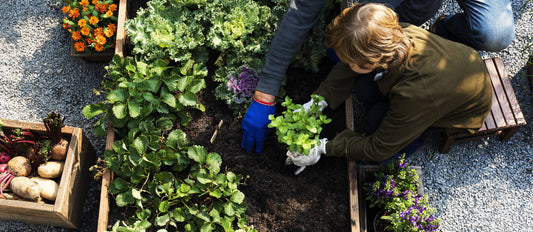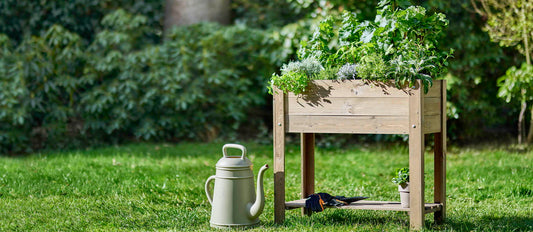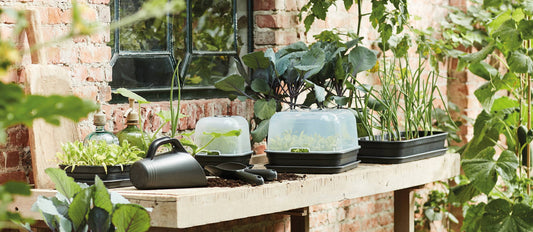The ideal time to start your (first) vegetable garden is in the spring. The sun is starting to shine again and your vegetables, fruit and herbs just love that. Planting in the spring will yield a harvest as early as the summer. Vegetable gardening has also been a growing trend for a number of years – it' fun for everyone. Want to join in? Bakker is happy to help you with the basics, so that you can soon start enjoying your own crop. In this blog post, you'll be taken through what is needed to start your first vegetable garden. Are you already quite far with your preparations? Then continue through to the next article about making a vegetable garden plan – read it here.
Vegetable gardening: you can do it almost anywhere
Thinking about vegetable gardening often brings a glass cabinet in the garden to mind, but it's not essential! You can plant a vegetable garden in many more places than you might think: in a large garden, in the vegetable garden box on the terrace, in a flower pot on your balcony, or even indoors – it's all possible. The location of your vegetable garden is very important. Many fruits and vegetables love a lot of sun. A south-facing vegetable garden will always do best. While this does not mean that it is otherwise impossible to grow a vegetable garden successfully, always choose the sunniest spot, even indoors.
A ready-to-use vegetable garden box
As soon as you have found the right place, get to work with the vegetable garden box. Of course, you could put one together yourself, but it is much easier to purchase a ready-to-use vegetable garden box. With the Elho growing table, you not only start your vegetable garden easily but also sustainably. This handy vegetable garden box is made from recycled plastic.
In a larger vegetable garden box, it is also useful to make different compartments, so that you can get started in an orderly manner. You can do this with small slats and labels to remember what you have planted. The back of the vegetable garden is an excellent spot to place a climbing frame. You can also grow climbing vegetables, such as grapes or aubergines all by yourself.
Start by sowing seed indoors
Some vegetables, such as tomatoes and peppers must be sown indoors. These plants will not survive if you plant them outside immediately. So let the seeds germinate indoors and grow into small plants before transferring them outside. For example, tomato plants must germinate and grow indoors for eight weeks before they can go outside. With other vegetables such as endive and various types of cabbage, it can also be an advantage to sow indoors first. You are not dependent on the weather indoors, so you can start sowing earlier. In some cases, it will also result in an earlier harvest.
Specific cultivation trays and cultivation pots are required for indoor sowing. Plant the seeds of the vegetables plants in the cultivation pots. Always make a hole at the bottom of the pots for good water drainage. Bakker's nature pots are also biodegradable. That means you do not have to transplant the vegetables – the roots can grow freely through the pot. Easy when you eventually move the vegetables outside. Watering is very important in the period immediately after planting. To water less often and to provide the plants with an ideal climate, place the cultivation trays in a greenhouse and place them in a warm room. For extra growth stimulation, you can consider using a heat lamp. These lamps also work perfectly for an indoor vegetable garden in a dark room. This way you ensure that your vegetables, fruit and herbs always get enough light and heat. Do you want to find out more about indoor sowing? Then read the following article about indoor sowing indoors.
Care is the foundation of a good harvest
It is well-known that potting soil is the basis for greenery. For vegetable gardening, Bakker recommends that you start with a special potting soil for the vegetable garden box. It contains all the nutrients that your fruit and vegetables need. The potting soil even contains enough nutrients to get through the initial period, without having to give extra fertilisers. After this period, which is always indicated on the packaging, you give extra nutrition in the form of vegetable garden food. It is preferable to use fertilisers with a plant-strengthening additive. A plant-strengthening additive ensures that the plant develops a stronger immune system and protects itself against pests and diseases. You can offer extra protection against insects by covering the vegetable garden with a fleece. A layer of mulch over the vegetable garden soil can also have a protective effect. Mulch improves the quality of the soil, stops weeds and retains heat and moisture.
It is always important to keep checking the vegetable garden for weeds and to remove them carefully. The roots of your vegetable garden plants can become entangled in the weeds. Once a week, check that there are no weeds growing. In general, it is easy to prevent in weeds with proper care and planting of different plant families in the vegetable garden box.
Get started with your new hobby
Do you want to get started with your vegetable garden? Here is a shopping list for your first vegetable garden supplies. You can even start sowing some vegetables indoors in winter, before planting up the whole vegetable patch outdoors in the spring. So, don't delay and buy in all your vegetable garden supplies now. There is another list of them for you below.
Essential for a healthy vegetable garden:
- Vegetable garden container for outside (in whichever size you want)
- Materials for organising the vegetable garden into sections
- Growing pots
- Greenhouse
- Potting soil especially for the vegetable garden
- Vegetable garden food
- And, of course, the seeds of your favourite vegetables, fruit and herbs!
Also useful:
- Heat lamps for the indoor vegetable garden
- A climbing frame for climbing vegetables and fruit
- Tarpaulin
- Seed spreader
- Garden tools for planting and caring for your vegetable garden




